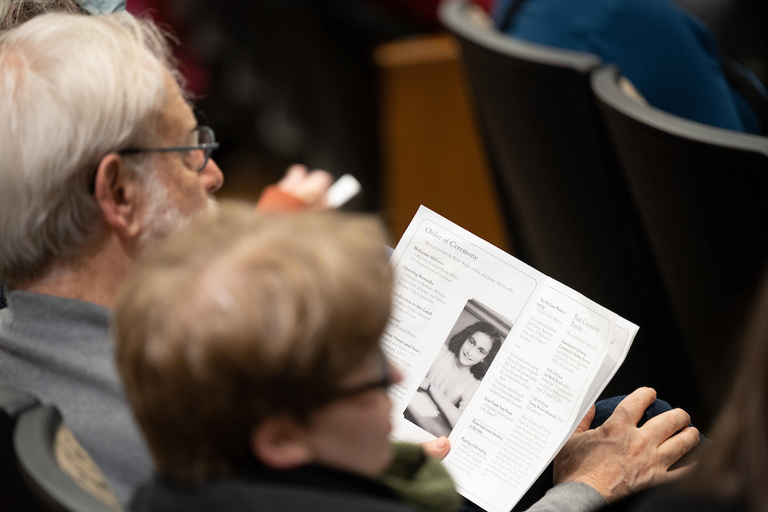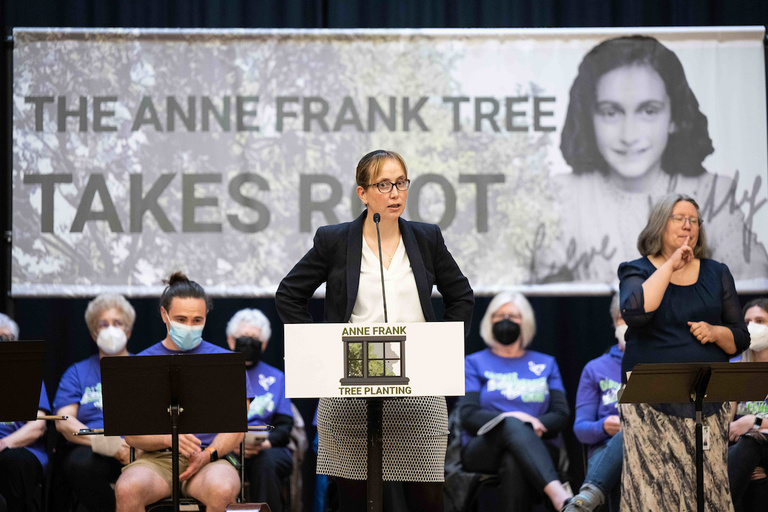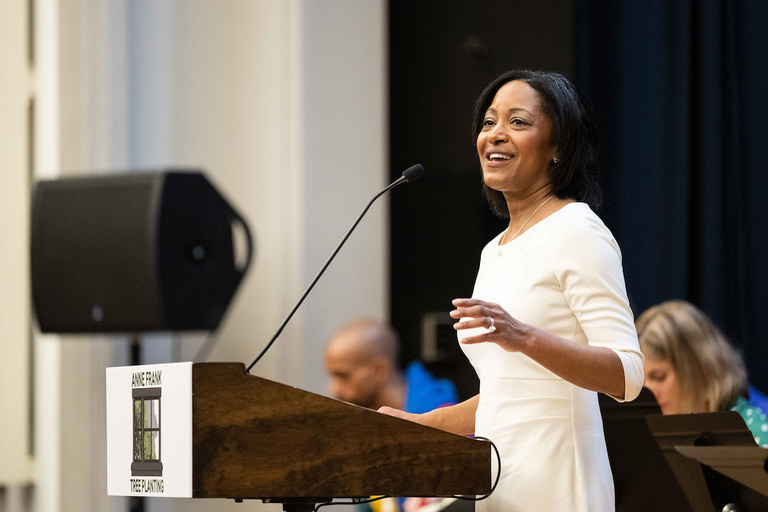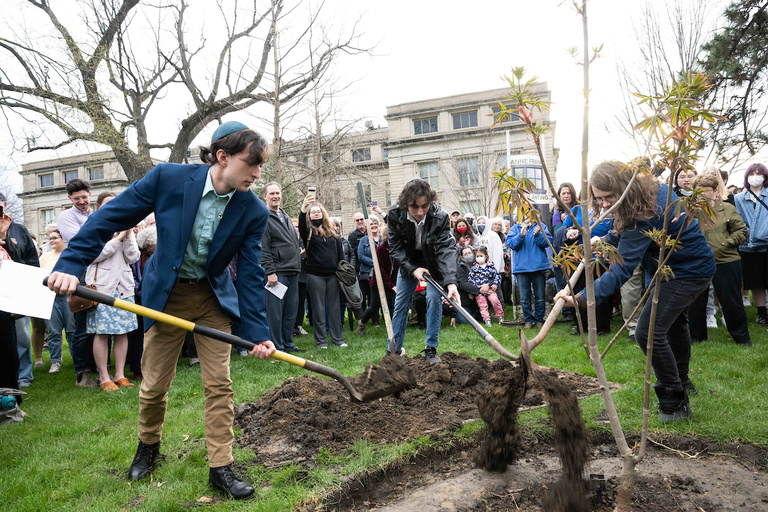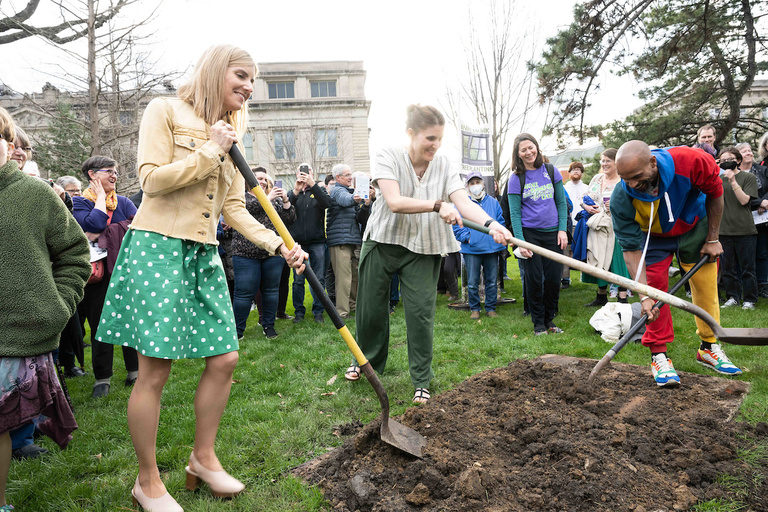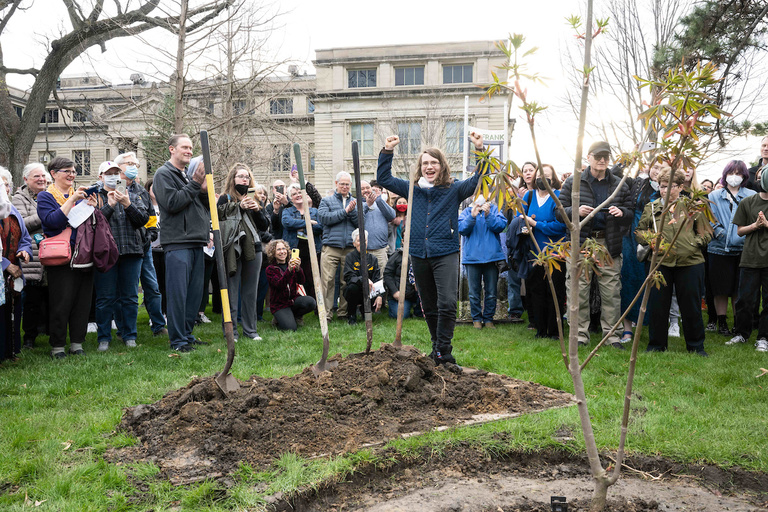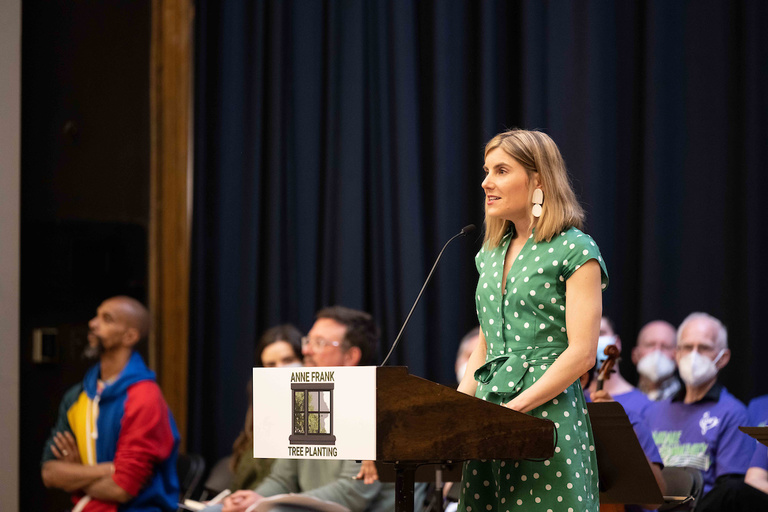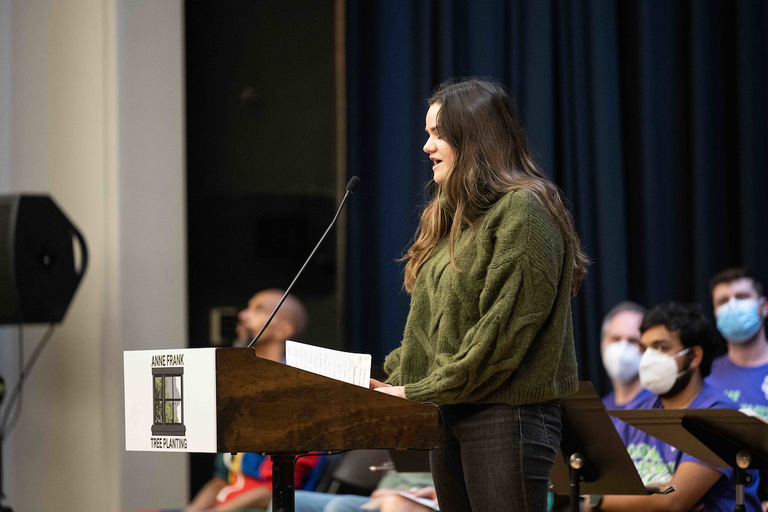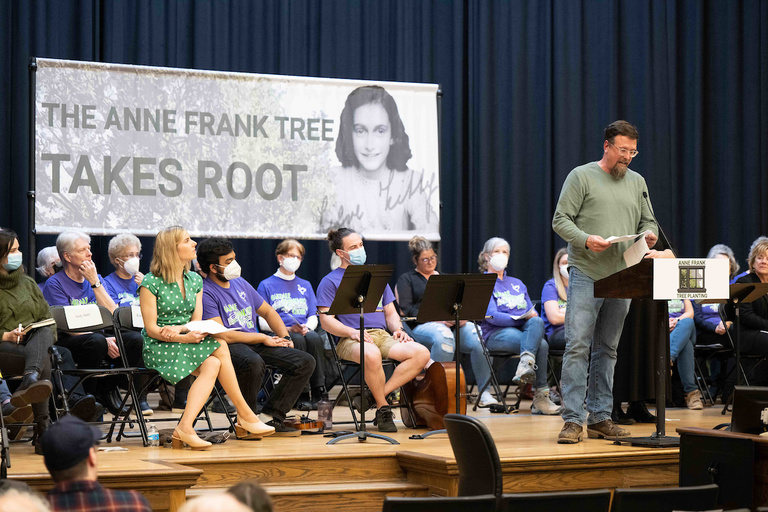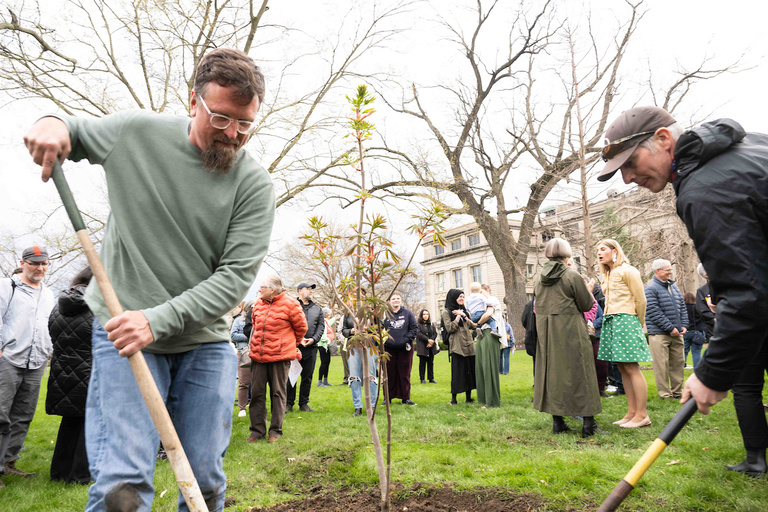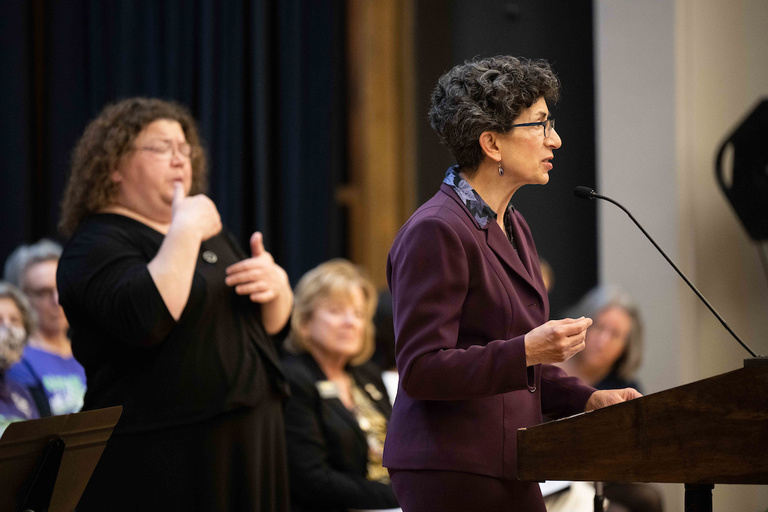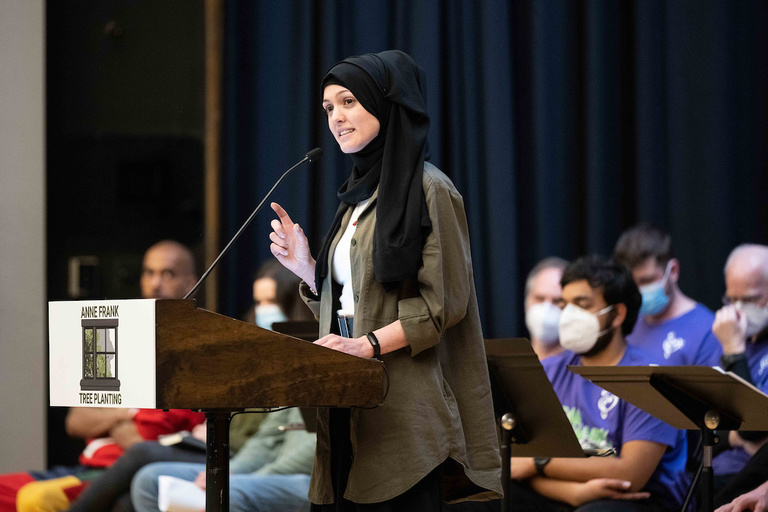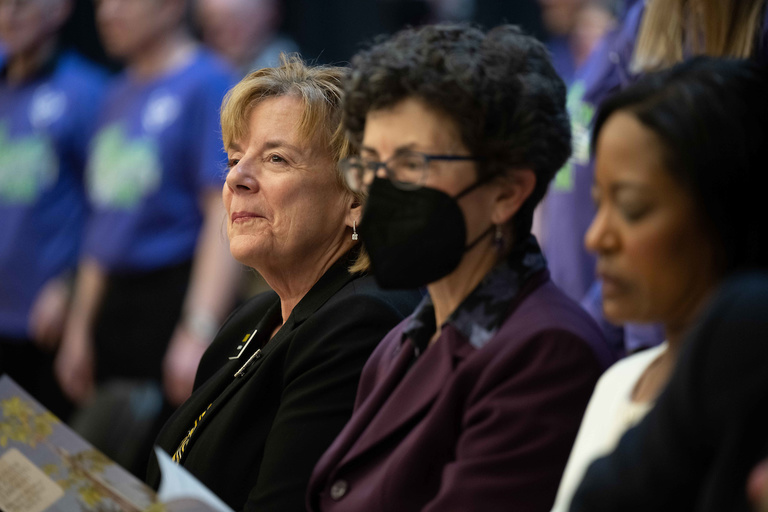The Tree Anne Saw
The original white horse chestnut tree stood in a courtyard behind the Secret Annex in Amsterdam. Anne could see its crown through an attic window that was one of the few windows that wasn’t blacked out. Although her father recalled that she hadn’t previously seemed very interested in nature, the tree, as well as the sky and birds that she could see became Anne’s lifeline. “To Anne, [the tree] represented life in the face of death, the freedom to blossom and prosper,” said Ronald Leopold, executive director of the Anne Frank House in Amsterdam
The tree outlived its young admirer by 50 years. One of the oldest chestnuts in Amsterdam, it collapsed in 2010; it was believed to be 170 years old. Seeds from the tree were germinated and saplings have been donated to schools named after Anne Frank all over the world, as well as to other organizations that share Anne’s humanitarian message.
"I look up at the blue sky and the bare chestnut tree, on whose branches little raindrops shine, appearing like silver, and at the seagulls and other birds as they glide on the wind. As long as this exists…and I may live to see it, this sunshine, these cloudless skies, while this lasts I cannot be unhappy."
The Sapling
In the few years before the Amsterdam chestnut tree’s demise, the stewards at the Anne Frank House wisely created saplings that have since been distributed to numerous locations around the world. In 2010, The Anne Frank Center USA in New York City received several of the saplings to donate to worthy educational organizations across the U.S. Following a three-year safeguard quarantine, they were cleared for planting in January 2013. Prior to the University of Iowa planting, there were a dozen U.S. sites that host the saplings:
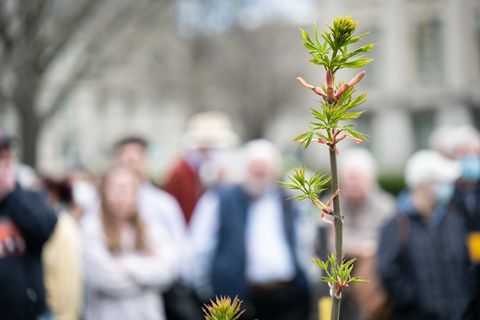
The white horse hair chestnut on its first day on the University of Iowa Pentacrest.
- U.S. Capitol, West Front Lawn, Washington, D.C.
- The Children’s Museum of Indianapolis, Indiana
- Sonoma State University, California
- Southern Cayuga School District, New York
- Washington State Holocaust Resource Center, Seattle
- Boston Common, Massachusetts
- Central High School, Arkansas
- Holocaust Memorial Center, Michigan
- Idaho Anne Frank Human Rights Memorial, Idaho
- William J. Clinton Presidential Center, Arkansas
- Liberty Park, Commemorating 9/11, New York City
- United Nations Headquarters, New York City
In 2019, UI faculty member Kirsten Kumpf Baele (German, CLAS) prepared a lengthy proposal for the University of Iowa to receive a sapling, including letters of support from the local Jewish community, the UNESCO City of Literature, and campus leaders. Her application was approved in 2020, and in spring 2022—following a wait due to COVID-19, a descendant of Anne’s chestnut tree was planted at the University of Iowa.
The thirteenth U.S. sapling was planted on the northeast corner of the UI Pentacrest on April 29, 2022. The green space that comprises four monumental limestone buildings and the original state capital of Iowa is the unofficial heart of the community—the place where campus and town meet. It has long been a space associated with free speech, protest, and celebration. In the summer of 2020, it was the site of Black Lives Matter protests, where young activists demanded reparations from Iowa City. In the 1980s, a small tent village of protestors was erected, with its protestor-inhabitants demanding divestment from South Africa by the University. And during the 1960s, it was the site of protests against the Vietnam War. A few blocks away, at the intersection of Iowa Avenue and Dubuque Street, climate activist Greta Thunberg spoke to thousands in October 2019, and then marched with local youth who are demanding that the UI cease the use of coal.
The University of Iowa has special designation by the Arbor Day Foundation as a Tree Campus USA. There are more than 300 species of trees on campus, including a rare American elm that survived the Dutch elm blight that killed many trees on the Pentacrest in the 1960s and 70s and an American chestnut (a relative of the white horse chestnut), another tree type that nearly disappeared because of blight.
Horse chestnuts are are known for their large oblong clusters of white flowers that bloom in spring. Leaves have an upright-oval rounded form with lower branches hanging down. Growing at a medium rate, a mature horse chestnut can reach a height of 50–75′ and have a canopy spread of 40–70′. It is native to the mountainous, wilds of Greece, Bulgaria, and Albania. It is not related–other than by name–to the American chestnut which used to cover great swaths of the eastern and middle United States until a blight in the early 20th century.
Other special trees include a grafted apple from the last remaining, documented Johnny Appleseed Tree, seven Iowa State Championship trees, and a William Penn Oak. Anne’s tree has literary company. Eight new saplings grafted from the trees that grew at the homes of authors such as Henry David Thoreau and William Faulkner were planted in Fall 2020.
To learn more about UI campus trees, please contact UI arborist Andy Dahl.
The Planting Ceremony
The Anne Frank Sapling was planted on Arbor Day 2022 (April 29) on the University of Iowa Pentacrest. Talks, spoken-word performances, and live music preceded the planting.
The planting of the sapling was led by the University of Iowa Forestry Team, Landscape Services, with local Jewish youth and members of the Planting Ceremony Team.
Welcome Address
Kirsten Kumpf Baele, PhD, UI Department of German
Opening Remarks
President Barbara Wilson, University of Iowa and Janice Weiner, Iowa City Councilor
Introduction to the Land
Andrew Dahl, Arborist, University of Iowa
“The Journey”
Kirsten Kumpf Baele
Excerpt from Stones and Stars
Performed and written by Emma Silverman, MFA candidate, University of Iowa Playwrights Workshop
Remarks
Liz Tovar, Executive Officer and Associate Vice President, Division of Diversity, Equity, and Inclusion, University of Iowa
Spoken-Word Performance
Amal Kassir, featured guest artist
Remarks and Blessing
Rabbi Esther Hugenholtz, Agudas Achim Congregation, Iowa City
“May My Tears Water a Sapling”
Oakdale Choir Singers; Choir leader and lyricist: Mary Cohen, Associate Professor, UI School of Music and College of Education
“Anne Frank Tree Poem”
Composed and performed by Jhe Russell, choreographer, teacher, and poet
Immediately following the ceremony — Community Shabbat Service led by Rabbi Esther Hugenholtz and Josh Hare, Iowa Hillel, Phillips Hall auditorium (Room #100)
6:30–9:00 p.m. — Let Me Be Myself exhibit, Phillips Hall (main floor, Center for Language & Culture Learning). The exhibit was on display in Phillips Hall from April 25–30, 2022.
7:30-8:30 p.m. — Young Writers Respond, Phillips Hall Auditorium. The Iowa Youth Writing Project, IC Speaks, and the UI Center for Human Rights asked students to respond to the legacy of Anne Frank, reflecting on her experience as a hidden person and her message about social justice. In this event, writers from junior high through undergraduate shared their entries. Local voices, as well as video addresses from young people around the world participated in these calls.
“Anne Frank Tree Poem”
by Jhe Russell
Performed at the Anne Frank Tree Planting Ceremony, April 29, 2022
No need for money in Memory Bank
Let me speak Anne Frank
The secret to Annex, flank
Annex means to tie by binding,
Drawing blank
Religion comes from religare latin
Also to tie by binding, my think tank
Tells me that cortex in brain means bark of tree
In etymology
Kabbalah means tree of life in this ministry
We must ask ourselves why we miss letters
From A to Z,
Kabbalah hides Allah unity within this holy sea
It will cost many to be hollow, love trees of immortality
We must rethink the term crazy,
Plants relate to all of us personally
Thalamus in brain in etymology means a flower
I had plants die and come back to life with power
From chanting hare krishna, i received new prayer plants in this tower
The term synagogue is pedagogue never sour
Ped means child, gogue means to protect in this hour
Anne Frank is every child to protect
We replant this tree of life in Iowa with human respect
Jhe Russell holds an MFA in dance from the University of Iowa. He is a choreographer, teacher, and poet.
- Kirsten Kumpf Baele, UI Department of German — co-chair
- Jennifer New, UI Obermann Center for Advanced Studies — co-chair
- Mary Cohen, UI School of Music and College of Education
- Andrew Dahl, UI Landscape Services
- Claire Frances, UI Center for Language & Culture Learning
- Josh Hare, Iowa Hillel
- Rabbi Esther Hugenholtz, Agudas Achim Congregation
- Heike Kumpf, Shive-Hattery Architecture & Engineering
- Susie Reagan, Agudas Achim Congregation
- Marisa Rethman, UI undergraduate research assistant
- Emma Silverman, MFA candidate, UI Playwrights Workshop
- With thanks to Erin Hackathorn and Jenna Hammerich at the Obermann Center for administrative and creative support.
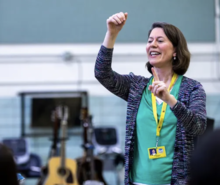
The Oakdale Community Choir & Mary Cohen
Led by UI faculty member Mary Cohen, the Oakdale Community Choir provides choral singing experiences for men (“inside singers”) in the general population of the Iowa Medical and Classification Center (Oakdale Prison) who are not restricted to their units and for women and men (“outside singers”) in the community who have an interest in learning more about issues in the prison system. The outside singers will perform a song written by Cohen, “May My Tears Water a Sapling” and invite the audience to join them.
Mary Cohen is an Associate Professor of Music Education at the University of Iowa. In 2009, she founded the Oakdale Prison Community Choir. Her research centers on music education as a tool for abolishing the prison industrial complex.

Emma Silverman
An MFA candidate at the Iowa Playwrights Workshop, Emma Silverman will perform a monologue from her upcoming UI New Play Festival work Stars and Stones. The work focuses on a young Jewish woman reckoning with the ghosts of her past and the apparitions of the present during and after a research trip to Poland. As she is launched back and forth through history, she is forced to consider the nature of her project while a scattering of strangers embark on their own moralistic journeys.
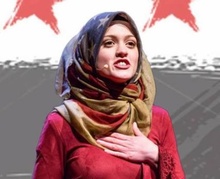
Amal Kassir
Amal Kassir grew up with a white Iowa-born mother and an Arab father, giving her a unique cultural experience that allows her to empathize with those struggling to balance their religious identity with their American one. A spoken-word artist, Kassir has performed in a dozen countries and over 50 cities, presenting in prisons, refugee camps, art fests, and colleges. With a strong belief in the power of storytelling to bring people together and help heal personal wounds and communal rifts, Amal is honored to participate in this event and help carry Anne Frank’s legacy into the current moment.
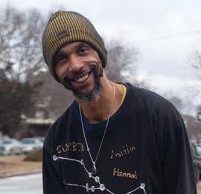
Jhe Russell
Jhe Russell holds an MFA in dance from the University of Iowa. He is a choreographer, teacher, and poet.
Lyrics from "May My Tears Water a Sapling"
May my tears water a sapling
May my life support its growth
May I walk with care and healing
For new life upon the earth
May our breath move with the Spirit
Flowing free around the earth
May we listen to the sunshine
And feel the moon reflect our worth.
